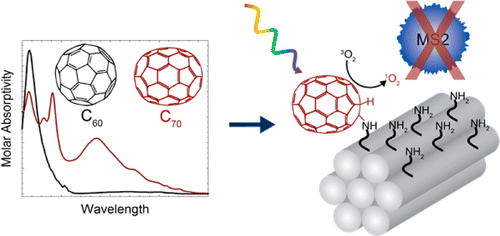
Chemical and Environmental Engineering graduate student Kyle Moor, in the lab of Jaehong Kim, has published his latest work in Environmental Science and Technology, demonstrating photocatalytic oxygen production in water using fullerene nanoparticles:
Improving the Visible Light Photoactivity of Supported Fullerene Photocatalysts through the Use of [C70] Fullerene
Kyle J. Moor , Dhyan C. Valle , Chuanhao Li , and Jae-Hong Kim *
Abstract:
We herein present the first instance of employing [C70] fullerene for photocatalytic 1O2production in water, through covalent immobilization onto a mesoporous silica support via nucelophilic amine addition directly to fullerene’s cage. This attachment approach prevents the aggregation of individual fullerene molecules in water, thus allowing fullerene to retain its photoactivity, yet is much less complex than other techniques commonly pursued to create such supported-fullerene materials, which typically rely on water-soluble fullerene derivatives and elaborate immobilization methods. The solid-supported C70 material exhibits significantly improved aqueous visible-light photoactivity compared to previous C60- and C60-derivative-based supported fullerene materials. Further, this material rapidly inactivates MS2 bacteriophage under sunlight illumination, oxidizes various organic contaminants, and does not appear to be significantly fouled by natural organic matter (NOM), highlighting the potential of these materials in real-world applications. Collectively, the ease of preparation and significantly enhanced visible-light photoactivity of these materials advance fullerene-based technologies for water treatment.